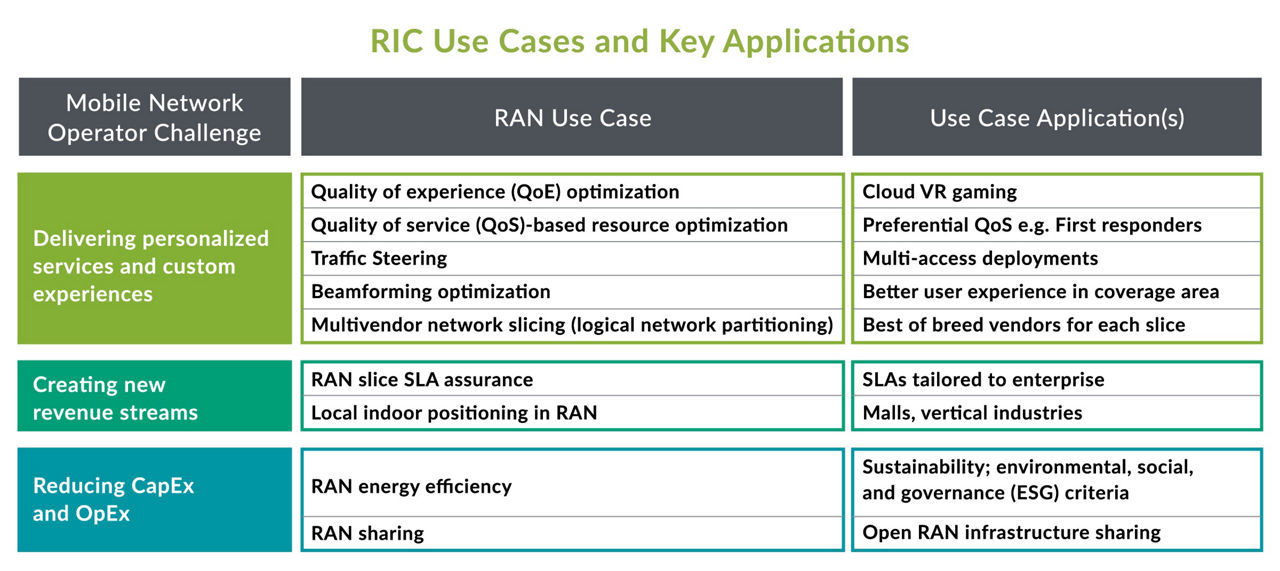What Is a RAN Intelligent Controller (RIC)?
What Is a RAN Intelligent Controller (RIC)?
A RAN Intelligent Controller (RIC) is a software-defined component of the Open Radio Access Network (Open RAN) architecture that’s responsible for controlling and optimizing RAN functions. The RIC is a critical piece of the Open RAN disaggregation strategy, bringing multivendor interoperability, intelligence, agility, and programmability to radio access networks. The RIC enables the onboarding of third-party applications that automate and optimize RAN operations at scale while supporting innovative use cases that lower mobile operators’ total cost of ownership (TCO) and enhance customers’ quality of experience (QoE).
What Problems Does RIC Solve?
The RIC helps mobile operators reduce both infrastructure and operational costs, improve network performance, and increase business agility. It also helps them build new revenue streams with personalized services, network slicing, and indoor location tracking capabilities. The O-RAN Alliance, a global community of mobile network operators, vendors, and research and academic institutions focused on open RAN standards and interoperability, has defined a set of use cases and applications that the RIC supports (see Figure 1).

Figure 1
How Does the RIC Work?
The RIC is divided into non-real-time and near-real-time components. The non-RT RIC is an element of the operator’s centralized Service Management and Orchestration (SMO) Framework, as defined by the O-RAN Alliance. Using specialized applications called rApps, the non-RT RIC enables > 1-second control of RAN elements and their resources. It also uses network data, performance metrics, and subscriber data to provide AI-based recommendations for network optimization and policy guidance to xApps running on the near-RT RIC, which in turn provides policy feedback to the non-RT RIC. The near-RT RIC resides within a telco edge or regional cloud and typically enables network optimization actions that take between 10 milliseconds to one second to complete (see Figure 2).
RIC Architecture

Figure 2
Juniper RIC Implementation
The Juniper RIC platform is based on a cloud-native microservices architecture and is fully compliant with the O-RAN specifications and interfaces. It supports both an open API and an SDK for integration with any third-party O-RAN-compliant xApps or rApps, giving network operators greater flexibility and choice of suppliers. The Juniper RIC integrates with the Juniper SMO, as well as other service-management orchestrator platforms.
Juniper’s approach simplifies application portability, giving developers and customers more options. When developing xApps or rApps for the RIC, developers can choose to use a network-based API, which eliminates compile-time dependencies, or an SDK-based API.

Figure 3
The RIC platform is also central to Juniper’s vision to build an SMO platform designed specifically for orchestration and automation at massive 5G scales. It’s open by design, using standardized interfaces to enable multivendor interoperability. Most important, it’s designed to help CSPs take full advantage of highly dynamic, software-driven architectures to transform their business. Juniper’s SMO offering delivers a management framework that is:
- Multicloud, to manage all network resources — across edge, regional, and national data centers, and public and private clouds
- Multidomain, to orchestrate network slices end to end across RAN, transport, and core network domains
- Multitenant, to support enterprise customers, mobile virtual network operator (MVNO) partners, neutral hosts, and others, and also deliver network slices tuned for each tenant’s unique application requirements
Juniper’s SMO offering consists of domain-specific modules to orchestrate network slices and resources in each subnet (O-RAN, transport, and core), all linked via a multidomain, end-to-end (E2E) service orchestrator. Together, this framework enables the on-demand creation and end-to-end management of network resources and slices across a distributed 5G infrastructure.
The Juniper SMO implementation supports the 3GPP-defined Communication Service Management Function (CSMF), Network Slice Management Function (NSMF), and Network Slice Subnet Management Function (NSSMF) standards.

Figure 4: SMO framework
RAN Intelligent Controller (RIC) FAQs
What is a RIC?
A RAN Intelligent Controller (RIC) is a software-defined component of the Open Radio Access Network (Open RAN) architecture that’s responsible for controlling and optimizing RAN functions.
What is a non-real-time RIC?
The non-RT RIC is part of the Service Management and Orchestration (SMO) Framework, centrally deployed in the service provider network, which enables non-real-time (> 1 second) control of RAN elements and their resources through specialized applications called rApps. Non-RT RIC communicates with applications called xApps running on a near-RT RIC to provide policy-based guidance for edge control of RAN elements and their resources.
What is a near-real-time RIC?
The near-RT RIC resides within a telco edge cloud or regional cloud and is responsible for intelligent edge control of RAN nodes and resources. The near-RT RIC controls RAN elements and their resources with optimization actions that typically take 10 milliseconds to one second to complete. It receives policy guidance from the non-RT RIC and provides policy feedback to the non-RT RIC through specialized applications called xApps.
Why is a RIC needed?
Why Is a RIC Needed?
The RIC is a cornerstone of the radio access network’s evolution to an open, intelligent, virtualized, and fully interoperable RAN. It allows mobile network operators to get the full benefits of the emerging Open RAN architecture, including innovative use cases for reduced TCO, RAN monetization, improved QoE, and multivendor interoperability.
What RIC technologies, solutions, and products does Juniper offer?
Juniper is developing both RIC and SMO solutions.
- An open and interoperable RIC platform to onboard Juniper and third-party xApps/rApps
- Juniper rApps and xApps for RAN slice SLA assurance, slice/tenant-aware admission control use cases, and energy efficiency
- An O-RAN SMO for orchestrating network resources and services in a next-generation RAN, fully compliant to 3GPP, O-RAN Alliance, and TMF standards
- A multi-cloud, multi-domain, and multi-tenant SMO platform to deliver end-to-end network slicing with prescribed SLAs across the RAN and transport and core networks

%20Panel%20Removing%20the%20Obstacles%20of%20Deploying%20ORAN%2000-00-06?fmt=png8-alpha)
